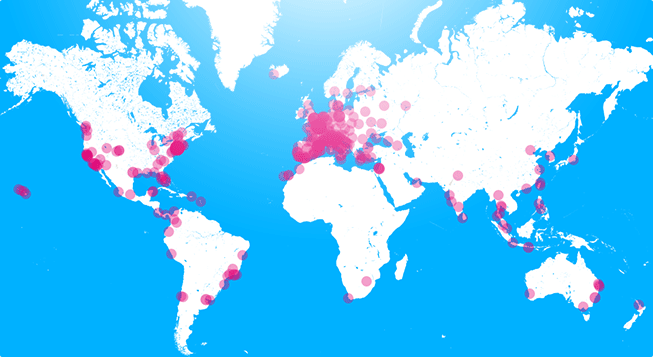Adobe Target
The most powerful solution for testing and targeting is
now easier to use than ever before. With the new Adobe Target, you get an
intuitive user interface, built-in best practices, and robust optimization
tools, so you can test quickly and often, target site visitors with confidence,
and create digital experiences that deliver real results. And real revenue.
Adobe Target capabilities
Easily set up and run concurrent tests to quickly determine the best offers, messaging, and sequences of content for your different visitor segments.
Use both partial and full factorial testing to understand the most impactful elements and best recipes for delivering real-time targeted content.
Use prebuilt or custom rules to target content to specific audiences based on hundreds of variables, including location, historical behavior, and more.
Automate the targeting of content to individual visitors using a self-learning algorithmic approach designed to increase conversion and discover key segments.
Leverage all available visitor and customer data to create custom segments, define effective strategy, and filter results at a granular level.
Make use of historical and affinity data to automatically deliver content and product recommendations.
HP Autonomy
HP Autonomy's ability to process
all forms of digital information on a single platform offers a unique solution
to a growing number of applications and devices that are increasingly dependent
on utilizing unstructured information. Through a combination of advanced
technologies for information processing, including over 500 analytical
functions available for text, it is possible for computers to form a contextual
understanding of unstructured digital content such as video and images, as well
as understand people's interaction with the data. For example, you can put the
abundance of social media data to work for you by detecting emerging trends and
influencers in this information, using HP’s sophisticated sentiment analysis
and clustering technology.
With the ability to connect to over
400 systems with support for over 1000 file formats, you can maximize your
information reach to find, monitor, capture, and analyze all relevant data. And
there is no need to move any data because now you can manage your data where it
resides—in its original repository—and ensure accessibility. The result: Big
data analytics made easy, with off-the-shelf connectors that deliver an
efficient, out-of-the-box solution for ingesting new data into Hadoop file
systems and a method of normalizing existing Hadoop data ready for the Map
phase.
HP Autonomy's technology eliminates
the traditionally manual and costly operation of processing and analyzing
information by performing these functions automatically and in real time. It is
easier to use and administer with a visual dashboard and simplified processes.
It delivers big data scalability and security so you can leverage our
established and proven best practices of supporting the largest enterprises in
volume of information, number of users, and frequency of transactions, while
adhering to strict security standards. These capabilities achieve substantial
savings and peace of mind for every type of organization and industry, and are
driving the accelerated adoption of HP Autonomy's technology across a diverse
range of vertical markets.
Maxymiser
Maxymiser empowers brands
to transform every digital interaction into seamless, relevant and engaging
customer experiences with its cloud-based testing, personalization and
cross-channel optimization solutions. Known for serving billions of individual
experiences across every device, Maxymiser leverages customer data to dramatically
boost engagement and revenue, while also driving long-term business value.
Recognized by Forrester Research as a leader in online testing, Maxymiser
serves nearly 10 billion experiences each month worldwide. Combined with a team
of vertically focused digital experts, Maxymiser’s Customer Experience
Optimization suite quickly delivers measurable results to every client through
A/B and multivariate testing, segmentation, behavioral targeting and product
recommendations for the web, mobile, social and email.
Maxymiser works with some
of the world’s most iconic brands, including HSBC, EPSON, Virgin Media, Alaska
Airlines, Harry & David, Progressive and Office Depot. Founded in 2006,
Maxymiser is headquartered in New York with offices in Chicago, Edinburgh, Dnipropetrovsk, Dusseldorf, London,
Munich and San Francisco.
An A/B and multivariate
testing solution that automatically optimizes experiences based on data
collected from actual customer interactions.
A rules-based targeting
solution that automatically mines customer data to identify unique segments in
order to deliver individualized experiences.
A behavioral targeting
solution that predicts and serves the most relevant content or offers to each
individual customer in real-time based on the individuals profile and behavior.
A recommendation engine
that serves the most engaging product and content recommendations at all stages
of the customer journey.
Extends testing
and personalization of content and offers to the mobile and tablet
channel thereby increasing conversion rates and revenue.
Provides the ability to
test and personalize Facebook pages and capture Facebook user profile data to
be used to personalize experiences on Facebook pages and a
brand’s websites.
Creates a 360-degree view
of your customers across all digital channels
to dramatically increase lifetime value
of individual customer segments.
A platform to deploy every
Maxymiser solution using a single line of JavaScript code.
Monetate
Monetate generates
billions of dollars of new revenue for businesses, helping them grow 39% faster
than the industry average. How does this happen? By helping you understand your
customers’ situations, behaviors, and preferences and act on those insights
with in-the-moment, relevant experiences targeted to the right customer at the
right time.
Business
growth is impossible without the ability to connect the teams and technologies
that power the customer experience. Monetate delivers win-win experiences by
connecting two crucial elements that have always been separate—customer
knowledge and marketing action—on every screen, in any channel, and at all key
phases of the relationship.
Optimizely
Optimizely was
founded by two former Google product managers, Dan Siroker and Pete Koomen. Dan
served as the Director of Analytics during the Obama 2008 presidential
campaign. While there, his team relied on the use of A/B and multivariate
testing to maximize e-mail sign-ups, volunteers, and donations
to raise more than $100 million in additional revenue for the campaign.
But
optimization was hard — you needed technical skills and know-how to run even
the simplest of tests. After the campaign, Siroker teamed up with Koomen to
create a world-class optimization platform that was easy to use in an effort to
provide a platform for businesses to be able to conceive and run experiments
that helped them make better data-driven decisions.
Since
completing YCombinator in the winter of 2010, Optimizely has seen strong and
growing demand.
The Highlights
·
In less than two years, our first product has
passed established players to become the leading A/B and multivariate
testing platform in the world.
·
More than 6,000 enterprises have adopted
Optimizely including Starbucks, Disney, and Salesforce.
·
From March 2012 to March 2013, the company
increased its revenue by more than 400% percent year-over-year. It first
reached cash flow positive in 2011.
SiteSpect
With SiteSpect, you can
accelerate site performance on every level.
SiteSpect is unlike any
other web and mobile optimization solution on the market today. That’s because
only SiteSpect makes it faster and more cost-effective to improve your site’s
conversion rates and performance. You’ll be able to rapidly test, target, and
optimize everything on your site without the latency introduced by JavaScript
tags – all while accelerating site speed, improving the user experience, and
enhancing your ROI.
Optimization made easy.
Only SiteSpect brings it
all together with the world’s only non-intrusive digital optimization platform
– a fundamentally different way to increase conversions. Consider a few of the
reasons why SiteSpect is the choice of leading online marketers worldwide. You
can:
Run and analyze test
campaigns – without code changes, JavaScript tags, and without ongoing IT
involvement – giving you more control over your optimization process.
Present the best content
for the right audience, including mobile users, by implementingbehavioral
targeting campaigns faster and seeing results quicker.
Quickly optimize any
mobile site without the speed and performance problems caused
by JavaScript testing solutions on mobile devices.
Measurably improve the
online customer experience by accelerating the delivery and rendering of web
and mobile content with SiteSpect AMPS®, a non-intrusive front end
optimization solution.
Easily test and optimize
the effectiveness of landing pages,
layouts, variations of copy, different offers, photos, navigation elements,
links, buttons, and more – all without having to change your existing site.










